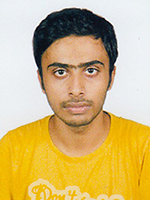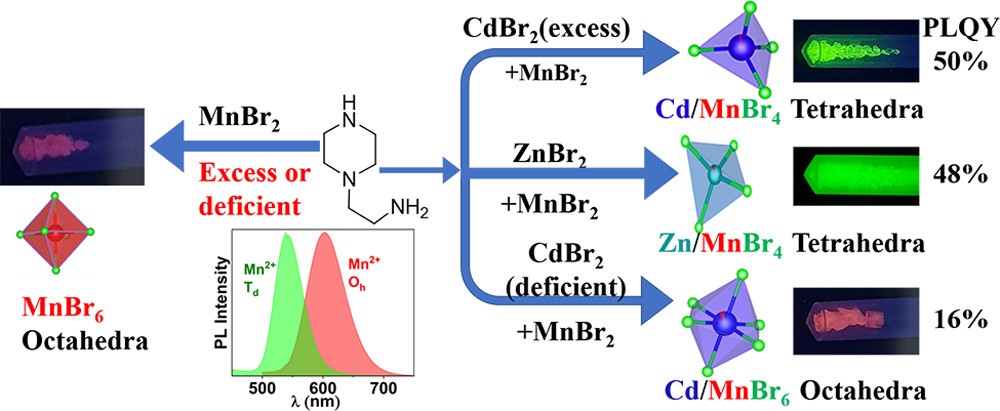Prime Minister’s Research Fellowship (PMRF)

Deep Kumar Das
Academic Background
I completed my Bachelors in chemistry from Chakdaha College, University of Kalyani. After that, I joined IISER Tirupati as an Integrated PhD student. Currently, I am Pursuing Ph.D. from IISER Tirupati. My research work mainly focuses on the Synthesis of mono-/multi-metallic low dimensional hybrid metal halides for structure-property correlation, elucidation and performance optimization in light emission and X-ray scintillation.
Research Interest
My current research work is focused on synthesizing and elucidating the structure-property relationship of single and multimetallic white light-emitting low dimensional networked organic-inorganic hybrid halide material and finding its application in light emission and X-ray scintillation. Low dimensional hybrid perovskites have a wide range of applications such as light-emitting diodes(LEDs), X-ray scintillation, remote thermometry, thermography, and many more. Besides considerable development in improving stability, luminescence properties in these materials, there is still a lack of knowledge on luminescence mechanism, changes in excited states during luminescence, and the role of structural distortion on emission. Along with this, investigation of new applications is also necessary. These hybrid halides, in a true sense potentially multifunctional material, but very few functions have been studied extensively. Nowadays, conventional white-light-emitting LEDs containing three different phosphors are suffering from low PLQY and colour rendering index(CRI) values. Also, commercial X-ray scintillators are expensive and have a low detection limit. Hence, any new material providing bright broadband emission, high PLQY, high CRI value, and a low detection limit is essential to produce next-generation cost-efficient white light LEDs and X-ray scintillators. These hybrid perovskite materials are promising candidates to fulfill these requirements and bring a revolution in optoelectronics.
The final research outcome could reveal the unresolved problem of the distortion-assisted luminescence mechanism. A more precise understanding of the structure-property relationship in these hybrid materials will help to develop stable, cost-efficient, and high-performance LEDs and X-ray scintillators.
Advisor Information
Dr. Janardan Kundu is an Assistant Professor in the Chemistry department at IISER Tirupati. He completed his Ph.D. from the Dept. Of Chemistry, Rice University, Houston, TX, USA in 2010. Subsequently, he worked as a postdoctoral fellow in the Center for Integrated Nanotechnologies, Los Alamos National Laboratory, Los Alamos, NM, USA, till 2013. Then, he moved to CSIR-NCL Pune as a Ramanujan Fellow.
His research interest primarily focuses on multifunctional materials that target applications in energy and the environment. Synthesis of metallic and semiconducting particles (bulk phase, nano phase, thin films) and device techniques constitute the major focus of his research.
Courses Done during PhD
None. All 86 credits taken in the first 2 years of integrated PhD programme.
Teaching Assistantships
- Chemistry Laboratory Course- CHM 212
- General Chemistry- CHM 111 (on going)
Publications
- Low Dimensional, Broadband, Luminescent Organic‐Inorganic Hybrid Materials for Lighting Applications J. Kundu, D. K. Das, Eur. J. Inorg. Chem. 2021, 2021, 4508.
- Synergistic electronic coupling/cross-talk between the isolated metal halide units of zero dimensional heterometallic (Sb, Mn) halide hybrid with enhanced emission A. Biswas, R. Bakthavatsalam, D. K. Das, J. Sam, B. P. Mali, C. Biswas, N. Manna, S. Thomson, S. S. K. Raavi, S. Kurungot, R. G. Gonnade, S. Dutta, J. Kundu, J. Mater. Chem. C, 2022,10, 360-370.
External Teaching Assistantships
Polymer Chemistry (at Sri Venkateshwara College of Engineering, Tirupati)
Open Seminar (the first stage of PhD):
Title: Halide Perovskite: A new game changer in CO2 photocatalysis
Date: 08/04/2022
The presentation was highly appreciated and approved by the committee members.
Work done under the PMR Fellowship programme:
Title: Controlled Modulation of the Structure and Luminescence Properties of Zero-Dimensional Manganese Halide Hybrids through Structure-Directing Metal-Ion (Cd2+ and Zn2+) Centers
Zero-dimensional (0D) metal halide hybrids with high exciton binding energy are excellent materials for lighting applications. Controlling/modulating the structure of the constituent metal halide units allows tunability of their photoluminescence properties. 0D manganese halide hybrids are currently attracting research efforts in lighting applications due to their eco-friendly and strong emission. However, structural transformation-induced tunability of their photophysical properties has rarely been reported. This work demonstrates a rational synthetic strategy to modulate the structure and luminescence properties of 0D Mn(II) halide hybrids utilizing the structure-directing d10 metal ions (Cd2+/Zn2+). 0D metal halide hybrids of Cd2+/Zn2+, which act as hosts with tunable structures, accept Mn2+ ions as substitutional dopants.

Achievements
Academic Excellence Award 2022
Publication
- Low Dimensional, Broadband, Luminescent Organic-Inorganic Hybrid Materials for Lighting Applications (Review)
- Kundu, D. K. Das, Eur. J. Inorg. Chem.2021, 2021, 4508.
- Synergistic electronic coupling/cross-talk between the isolated metal halide units of zero dimensional heterometallic (Sb, Mn) halide hybrid with enhanced emission
- Biswas, R. Bakthavatsalam, D. K. Das, J. Sam, B. P. Mali, C. Biswas, N. Manna, S. Thomson, S. S. K. Raavi, S. Kurungot, R. G. Gonnade, S. Dutta, J. Kundu, J. Mater. Chem. C, 2022,10, 360-370.
- Controlled Modulation of the Structure and Luminescence Properties of Zero-Dimensional Manganese Halide Hybrids through Structure-Directing Metal-Ion (Cd2+and Zn2+) Centers
- K. Das, R. Bakthavatsalam, V. Anilkumar, B. P. Mali, M. S. Ahmed, S. S. K. Raavi, R. Pallepogu, J. Kundu, Inorg. Chem.2022, 61, 13, 5363–5372.


